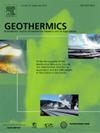Use of ground magnetic survey in exploration of geothermal springs in a metamorphic terrain: A case study from Sri Lanka
IF 3.9
2区 工程技术
Q3 ENERGY & FUELS
引用次数: 0
Abstract
Magnetic surveys map anomalies by detecting interferences in the Earth’s magnetic field caused by subsurface features. Metamorphic terrains, shaped by intense pressure and temperature, often host fractures and faults that channel fluid flow and are frequently enriched with ferromagnetic minerals. These structures can be effectively identified using ground magnetic surveys due to their distinct magnetic signatures. A magnetic survey was carried out in the Wahawa-Padiyathalawa hot spring area, Sri Lanka, to explore the subsurface geology and structures and their links to thermal discharges. An “Overhauser” magnetometer with GPS was used to collect magnetic data every two seconds across a 15 km² area, avoiding manmade interferences. Anomalies were corrected using International Geomagnetic Reference Field (IGRF) values, and Oasis Montaj® software was used for analysis. Filters such as Reduction to Equator (RTE), Pseudo-gravity, and Tilt Horizontal Derivative (THDR) were applied to enhance signals and highlight specific geological features.
The results reveal that RTE transformation poses challenges in interpreting geological structures due to paired dipoles and signal interference. In contrast, THDR and pseudo-gravity transformations provide clearer views of surface and subsurface features respectively. The hot spring cluster lies within high THDR and pseudo-gravity anomaly zones, indicating a strong relationship to surface and subsurface structural lineaments. The hot spring cluster connects with the surface structural lineaments in the THDR anomaly map. Pseudo-gravity map shows that the dolerite dyke disrupts subsurface fractures, suggesting it acts as a barrier to deep fluid flow and contributes to thermal spring formation. This study highlights the value of ground magnetic surveys, combined with THDR and pseudo-gravity transformations, in mapping structural controls on geothermal springs in metamorphic terrains.
地磁测量在变质地层地热泉勘探中的应用:以斯里兰卡为例
磁测量通过探测地下特征对地球磁场的干扰来绘制异常图。变质地形受高压和高温的影响,通常有裂缝和断层,这些裂缝和断层引导流体流动,并且经常富含铁磁性矿物。由于这些结构具有明显的磁特征,因此可以通过地面磁测量有效地识别它们。在斯里兰卡Wahawa-Padiyathalawa温泉地区进行了磁测,以探索地下地质和结构及其与热排放的联系。利用装有GPS的“Overhauser”磁力计,在15平方公里的区域内每两秒钟收集一次磁数据,避免了人为干扰。利用国际地磁场(IGRF)值对异常进行校正,并使用Oasis Montaj®软件进行分析。采用赤道还原(RTE)、伪重力和倾斜水平导数(THDR)等滤波器来增强信号并突出特定的地质特征。结果表明,由于偶极子和信号干扰,RTE变换给地质构造解释带来了挑战。相比之下,THDR和伪重力变换分别提供了更清晰的地表和地下特征视图。温泉群位于高THDR和伪重力异常区内,与地表和地下构造线有很强的关系。在THDR异常图中,温泉群与地表构造线相连接。伪重力图显示,玄武岩岩脉破坏地下裂缝,对深部流体流动起到屏障作用,有利于温泉的形成。本研究强调了地磁测量结合THDR和伪重力变换在确定变质地块地热泉的构造控制作用方面的价值。
本文章由计算机程序翻译,如有差异,请以英文原文为准。
求助全文
约1分钟内获得全文
求助全文
来源期刊

Geothermics
工程技术-地球科学综合
CiteScore
7.70
自引率
15.40%
发文量
237
审稿时长
4.5 months
期刊介绍:
Geothermics is an international journal devoted to the research and development of geothermal energy. The International Board of Editors of Geothermics, which comprises specialists in the various aspects of geothermal resources, exploration and development, guarantees the balanced, comprehensive view of scientific and technological developments in this promising energy field.
It promulgates the state of the art and science of geothermal energy, its exploration and exploitation through a regular exchange of information from all parts of the world. The journal publishes articles dealing with the theory, exploration techniques and all aspects of the utilization of geothermal resources. Geothermics serves as the scientific house, or exchange medium, through which the growing community of geothermal specialists can provide and receive information.
 求助内容:
求助内容: 应助结果提醒方式:
应助结果提醒方式:


